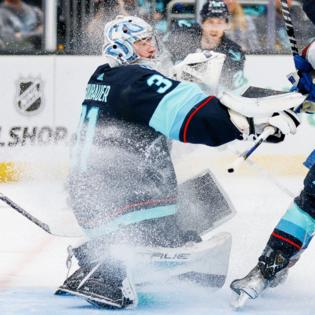Kate Shefte: Hockey's unwritten rules: Here's why you don't snow the goalie
Published in Hockey
SEATTLE — The goal is tantalizingly close. Endorphins and emotions are high. But according to hockey etiquette, there's just no need to hit the brakes suddenly, sending a wave of accumulated ice shavings over and into the helmet of the goaltender.
At first glance, "snowing" the goalie appears perversely satisfying — what anyone might do if they were capable of skating at high speeds. But it's happening right in someone's face.
It's disrespectful, and it doesn't feel great, as Kraken goaltender Philipp Grubauer described:
"It's like dumping cold water. It takes a couple of seconds to take your vision back, and sometimes you need to go to the bench to flush it out. There are small pieces of ice, shards, stuck in your eyes until they melt."
As his blurry vision clears, he sees his teammates descend, referees hot on their heels. An unwritten rule of hockey has been tested or even broken.
"If [the offender] is coming in at the same time as the defenseman, it's a little different story," Kraken alternate captain Adam Larsson said.
"If you look like you're intentionally spraying him, it's probably going down."
In the uncommon event it's too egregious, snowing the goalie can lead to an unsportsmanlike penalty. More often than not, this matter is left to players to police. A shove, some colorful language, maybe a good, long, forced sniff of your opponent's smelly hockey glove. Or a firm strike of the stick to send the point home.
Sometimes they let the aggrieved party handle it himself. In a March 16 game against the Predators, Nashville forward Jason Zucker grazed Grubauer's crease. The Seattle netminder had endured enough. He dropped Zucker with a cross-check to the collarbone. The officials let it slide.
In those instances, Larsson will look on in approval.
"They take a lot of beating," the veteran defenseman said. "They should be able to give it back sometimes, too."
Which player it is plays a part in how Grubauer handles the situation. Same with Kraken defenseman Brian Dumoulin, who has played in the NHL for a decade and counting. He'll glance at the player number, sometimes, and note the agitators. That goes a long way in sussing out motive and guilt.
"If it's avoidable, obviously, there's no need to do it," Dumoulin said.
Infamous Boston Bruins pest Brad Marchand earned an unsportsmanlike penalty in Game 7 of a 2014 second-round series for giving Canadiens goalie Carey Price a cold blast to the face. His reputation probably didn't help him in that moment. Boston went on to lose that pivotal game 3-1.
Sometimes it's not really avoidable. A player gets cut off, maybe, and has nowhere else to go.
"I'd rather have them stop right in front of me and spray me a little bit than run me over," Grubauer said wryly.
In terms of treatment, Grubauer compared the hockey goalie to the football quarterback. He's vulnerable back there, well padded but stationary while some of the world's fastest skaters barrel in on him. He must be protected.
That goes for his spirit as well. Another unwritten hockey rule is that you don't fire the puck into the net after the whistle, or really any time it's undeserved. Part of it is pride with a dash of superstition — the goalie shouldn't have to fish the puck out of his net, even when it doesn't count. Teammates don't want him worrying about those extracurriculars.
Two superstitions came to a head in 1987 during a pregame brawl between the Philadelphia Flyers and Canadiens before a playoff game at the Montreal Forum. Montreal's Claude Lemieux and Shayne Corson had been firing pucks into the empty net at the end of warmups, toying with the Flyers' goalies, who had been turning the net around to prevent it. Flyers defenseman Ed Hospodar wearied of this and started pummeling Lemieux after the latest offense, and soon everyone spilled from the locker rooms onto the ice for nine-and-a-half minutes of fights.
There were no referees on the ice yet and no penalties were assessed because the game hadn't started, but there were $500 fines levied all around and Hospodar was suspended for the rest of the playoffs. Harsher league rules were instituted a few months later, intended to prevent multiplayer brawls.
Firing the puck in when play is stopped is not only discourteous, but dangerous. Those on the ice have eased up during the lull in play, probably not ready for vulcanized rubber flying their way. The goalie could be headed to the bench, or turning around for a drink of water.
"It's not like basketball, where you can kind of shoot off the whistle," Biddeford, Maine, native Dumoulin said, helpfully throwing in a comparison for non-hockey sports fans.
"Here, there's usually a lot of guys in front of you. And maybe the goalie's stopped paying attention. There's definitely room for injuries in that."
There are plenty of other ways to make your cheeky point.
"I just don't think it's a good look," Larsson said.
In sport, you defend the color you're wearing. When there's a hockey net or face full of something that shouldn't be there, anger and message-sending follows. And for the record, if the roles were reversed, Grubauer would do the same.
"If something happened, I would do the same thing for other guys," Grubauer said.
"You have to protect your teammates."
———
Editor's note: This is part of an occasional series of the unwritten rules of hockey.
©2024 The Seattle Times. Visit seattletimes.com. Distributed by Tribune Content Agency, LLC.







Comments